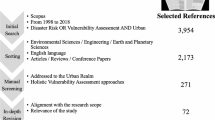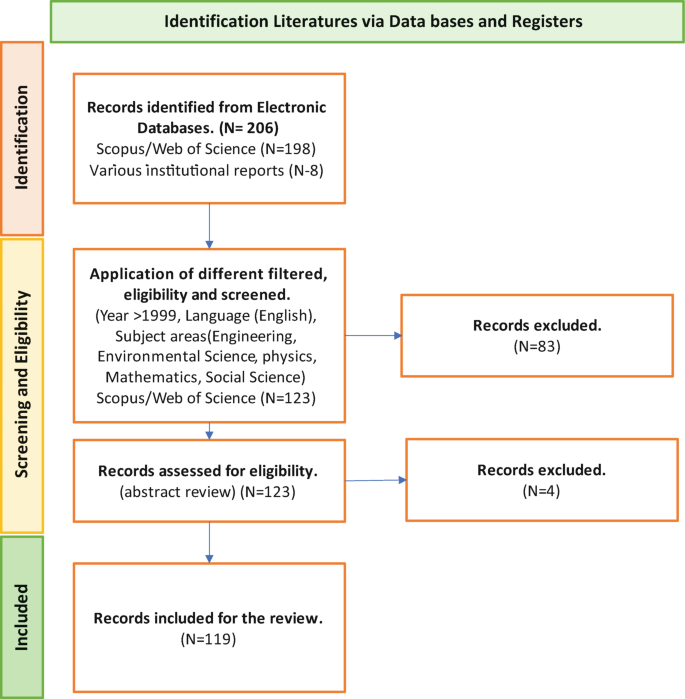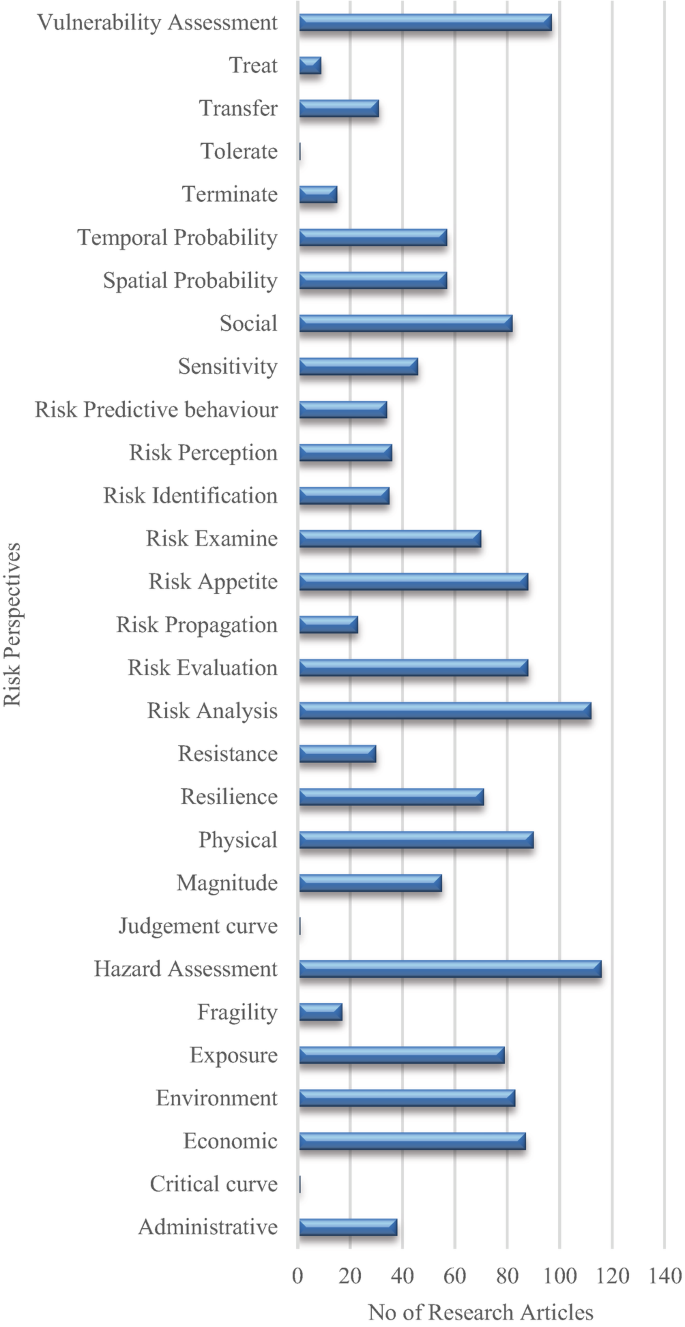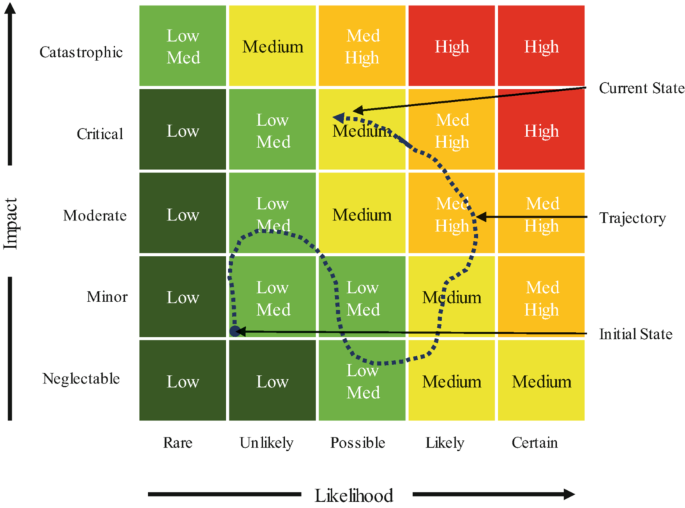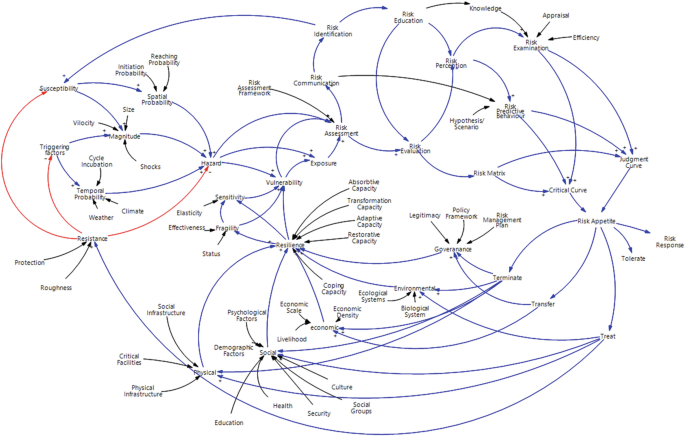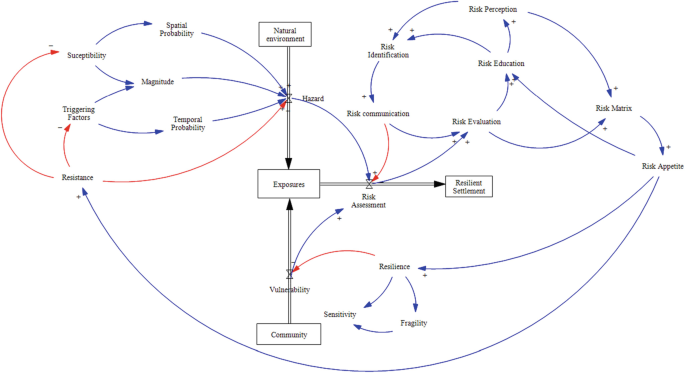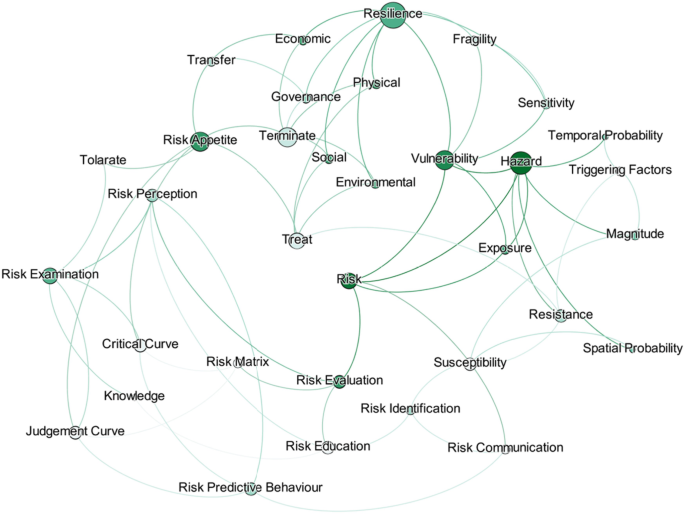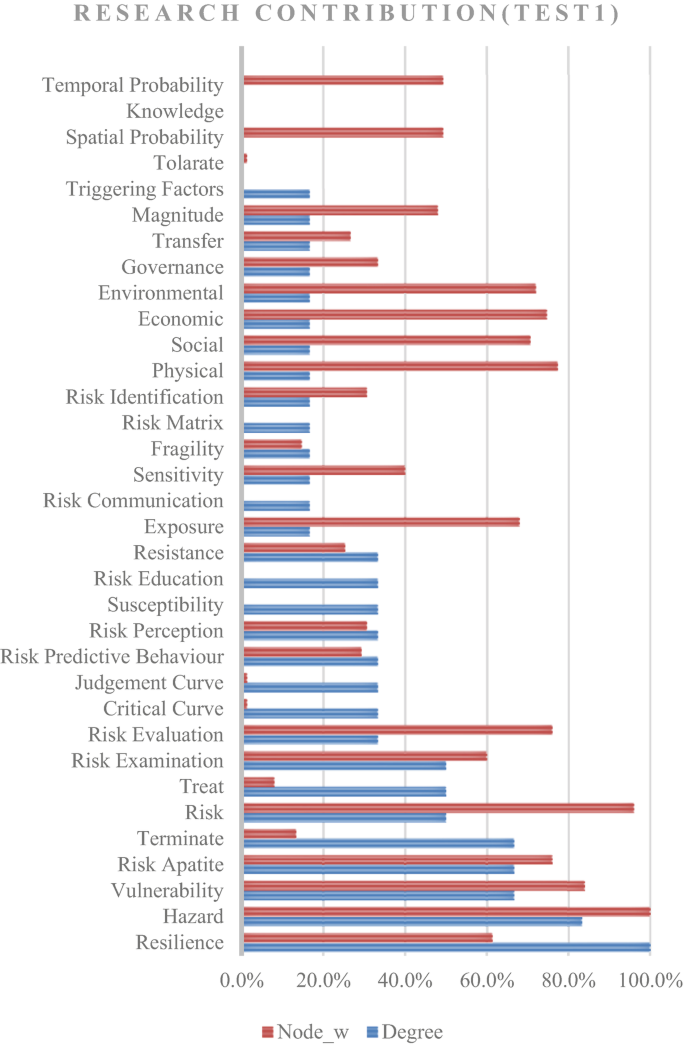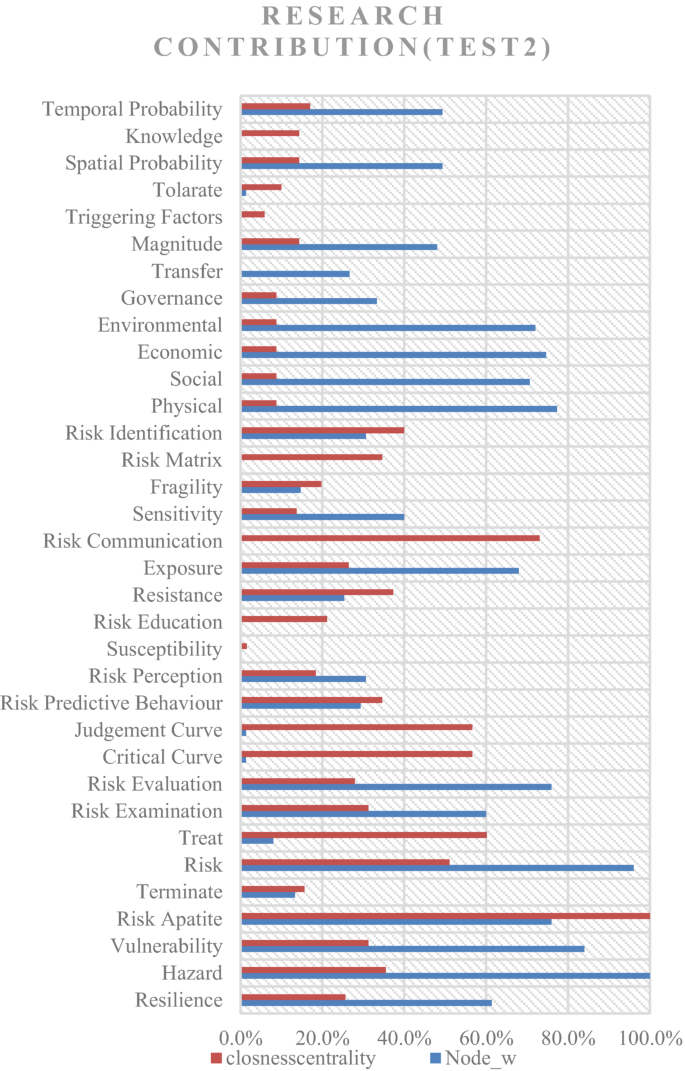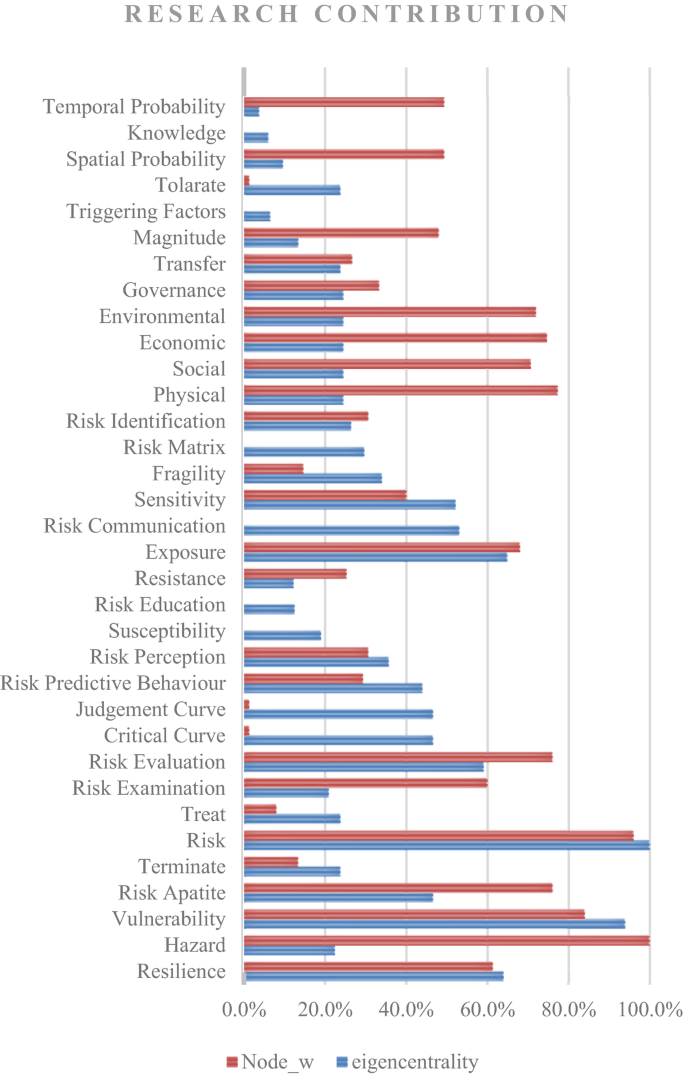Abstract
Researchers have explored different risk assessment approaches from the perspectives of different disciplines to capture urban risks, resulting in many risk assessment frameworks. In these frameworks, the risk environment is analysed using different quantitative and qualitative assessment methods, such as fuzzy set, probability theory, and evidence theory. While each approach has contributed to risk assessment, they suffer from a lack of consensus in defining and measuring the impact of risk in an urban environment.
Therefore, the study aims to conduct a literature survey to consolidate a common set of risk assessment perspectives and approaches for measuring these risks.
A structured review was carried out to achieve the aim of this research. The research question used for conducting the literature review was “What approaches are being used to define and measure the impact of hazard risks in an urban environment?”. The PICO (Population, Intervention, Compression Intervention, and Outcome) method was used to generate the search string for the literature review by considering the keywords in the research question. Initially, 206 research papers were selected through a search strategy, and by applying a screening method, 119 research articles were selected for the detailed review. The Nvivo software was supported for the review purpose; then, a mind map was developed, integrating all the risk assessment perspectives.
Risk assessments were summarised by considering the various researchers’ perspectives. Thirty-four risk perspectives were identified through the literature, and a mind map was developed to understand the connectivity. This mind map was converted into a network diagram, and future requirements of risk perspectives were identified based on the risk assessment network diagram. According to the analysis, risk communication, risk treatment, critical curve, judgment curve, and risk matrix could be identified as future research areas. The risk reduction measuring strategies were identified by considering the feedback loop of the network diagram. Thus, 14 risk reduction strategies could be identified through the analysis.
The risk assessment frameworks focused on holistic approaches, but most research studies did not adequately follow the risk perspectives. Therefore, research gaps were identified in the risk assessment process, and the areas were highlighted as state-of-the-art to conduct future research studies. The feedback loops of the network diagram emphasised the risk reduction strategies, which could be further researched through application to a case study.
You have full access to this open access chapter, Download chapter PDF
Similar content being viewed by others
Keywords
1 Introduction
Disaster Risk Assessment (DRA) is a fundamental activity necessary for establishing a clear understanding of local risks to implement appropriate interventions for risk reduction activities and build resilient urban environments. Therefore, there are many international efforts to encourage governments to implement DRA to create sustainable cities and communities through partnerships (Nations U 2015b). For example, many disaster risk reduction action plans such as the International Decade for Natural Disaster Reduction (Nations 1989), the Yokohama Strategy and Plan of Action for a Safer World, the Hyogo Framework for Action (HFA) (2005–2015), Sendai Framework for Disaster Risk Reduction (2015–2030) are calling for governments to focus on disaster risk reduction against climate-induced disasters (Nations U 2015a). In this context, the Sendai Framework calls for strengthening the scientific capacities to develop or apply DRA methodologies and frameworks to assess vulnerabilities, exposure, and disaster risks for various hazards (Nations U 2015b). Such risk assessment frameworks need to take a systemic view of DRA within urban environments by considering the interdependencies of various subsystems and help city governors fully understand the cascading impact of hazards across various subsystems and domains (Hasani 2014).
Due to the complex relationships that exist among the risk assessment variables, researchers have explored different risk assessment approaches, resulting in many risk assessment frameworks (Khazai et al. 2014; Yeganeh and Sabri 2014; Zlatanova et al. 2014; Munasinghe and Wijegunarathne 2015; Torre et al. 2019; Huang et al. 2020). In practice, different institutions and countries have used different risk management frameworks for assessing disaster risks in their local contexts.
A risk management framework is a guided process on risk management principles, policies, and practices developed more systematically by various institutions. Pedro Basabe (2018) has divided these frameworks into four categories: (1) Generic Principles, guidelines, and methods, (2) Applied principles for governmental organisations, (3) Intergovernmental framework, and (4) National Institutionalised Framework. The examples of category one frameworks on “Generic principles” include ISO31000 and IRGC risk frameworks which are purely theoretical frameworks. In contrast, OECD and UNECE risk assessment frameworks are category two frameworks on “Applied principles for governmental organisations”, which are focused on a specific thematic area (OECD 2012). For example, the OECD methodology, developed by G20 countries, focused on assessing the financial risk status of a country (OECD 2012). On the other hand, the Sendai Framework, introduced by UNISDR, is an example of a category three risk framework on “Intergovernmental risk management”, which proposes seven targets and four priorities that are aimed at supporting the reduction of existing and new disaster threats (UNDRR 2015). In contrast, the National Risk Register, prepared by the UK cabinet office, describes the national risk reduction approaches aligned to the National Institutionalised framework type, which comes under category four (Cabinet-Office-UK 2020).
Even though the risk frameworks are different, these frameworks possess common characteristics since they all focus on risk, vulnerabilities, and their causes and consequences. They focus on hazards, existing linkages to development, risk governance and regulations (Pedro Basabe 2018). Therefore, it is essential to understand these frameworks’ common characteristics and terminologies to establish a holistic risk assessment approach (Hasani et al. 2014).
In these frameworks, the analysis of the risk environment is carried out by using different quantitative and qualitative assessment methods. Some examples of methods used in risk assessment include possibility theory, fuzzy set, probability theory, and evidence theory (Giorgini 2009). Aksha et al. (2020) have identified various limitations in these current multi-hazard risk assessment approaches, which include: a lack of standard definitions for multi-hazard risk, lack of a holistic approach for integrating risks from different hazards, unavailability of intensive data required for risk assessment, confinement of risk assessments within disciplinary boundaries, and the inherent uniqueness of each place generating geographically specific hazard conditions and outcomes.
Therefore, this study aims to understand how the risk assessment characteristics are discussed in various research studies in the urban environment. It aims to answer the question “What approaches are being used to define and measure the impact of hazard risks in an urban environment?”
2 Literature Survey
This section discusses the literature review approach used to gather relevant research papers to explore the research question. The PICO method was used to generate the search string by considering the keywords in the research question for identifying the relevant literature. The PICO represents four groups: Population, Intervention, Compression intervention, and Outcome. Table 1 presents the initial and extended keywords identified for the literature review.
The keywords were connected with “AND” or “OR” operations. The “OR” connection was used to connect within the group, and the “AND” connection was used to connect between the groups. The following literature searching statement was used to search the research papers that match with keywords, abstract and title of the research papers in the Scopus and the Web of Science databases. Further, eight reports were collected from intergovernmental organisational websites. A total number of 206 research articles were selected for screening.
Literature search statement: (‘Urban’ OR ‘Urban Infrastructure’ OR ‘Urban Development’ OR ‘Urban design*’ OR ‘Urban Plan*’ OR City OR Town) AND (Hazard OR Risk OR ‘Cascading effect’ OR Propagation OR ‘Cascading failure OR ‘Chain Reaction’ Or ‘System thinking’ OR ‘System Dynamics’ OR interdependence*) AND (Resilience OR Impact OR Disaster OR Perturbation OR Damage OR Failure) AND (Model* OR Theory* OR Method* OR Formulas OR Index OR Eq. OR Approach OR Simulation).
Figure 1 shows the PRISMA method of screening the literature records for the study. The following inclusion criteria were used to select the most relevant papers for this study, which are most relevant to generate risk propagation modelling: consider only the research papers published after 1999 in English; consider papers only from the key subjects areas Engineering, Environmental science, Physics, Mathematics, and Social Science, which are more relevant with the research scope. This process resulted in 123 papers for further consideration. After reading the abstracts, only 119 research papers were selected for the full paper review process.
2.1 Detailed Review Process
A systematic/ mapping review approach was selected because of mapping the existing characteristics on a network diagram. Accordingly, each research paper was reviewed to identify key risk assessment characteristics and make a network diagram. The Nvivo12 Pro software was used to support the literature review (Sweet 2014), and cases/nodes were created for each risk character. Figure 2 shows different risk management perspectives that were addressed in the chosen research papers in this study.
2.2 DRA Characteristics and Percentage of Research Interests
According to the review, 94% of the research papers discussed the risk analysis approaches, and in there, hazard assessments (97%); vulnerability assessment (82%); exposures (66%); risk propagation (19%); and risk perception (30%) were discussed. Although risk appetite was discussed in 74% of the research papers, this aspect was not discussed in detail. For example, the key elements of risk appetite, such as risk thresholds, risk tolerance, and critical or judgment values, were only found in 1% of research studies. The following section discusses the risk analysis and risk analysis methods in detail.
3 Risk Assessment
The risk assessment is an important study in risk management and is conducted to assess the risk status of the community. According to Zlatanova et al. (2014), risk management is comprised of four major phases; (1) risk identification, (2) risk evaluation, (3) choice and implementation of risk reduction measures and instruments, and (4) monitoring and maintenance of acceptable risk. Within this context of risk management, the first two phases (risk identification and risk evaluation) belong to the risk assessment. However, it is evident that there are many ways to define the key risk assessment activities. For example, ISO-Guide73 (2009) has defined risk assessment activities as risk understanding, analysis, and evaluation.
In contrast, Corominas et al. (2013) have proposed risk analysis and risk evaluation as the key phases in risk assessment, where the key activities of risk analysis are hazard identification, hazard assessment, inventory of elements at risk and exposure, vulnerability assessment, and risk estimation. In this phase, hazard identification is the initial step for gaining insights into any threat, uncertainty, vulnerability, and unexpected event that can become a source or trigger for risk to materialise (Tran et al. 2018). Risk evaluation is the stage at which values and judgments enter the decision process, explicitly or implicitly, including considerations of the importance of the estimated risks and the associated social, environmental, and economic consequences to identify a range of alternatives for managing the risks (Corominas et al. 2013).
Risk Evaluation is considered an essential step in the risk assessment process to guide how to improve the current system to face future risks. At this step, values and judgments enter the decision-making process, explicitly or implicitly, to consider the severity of the estimated risks and the associated social, environmental, and economic consequences and to identify a range of alternatives for managing the risks (Corominas et al. 2013).
3.1 Risk Analysis
There is no exact definition for risk, which varies from discipline to discipline (Stock and Wentworth 2019; Aksha et al. 2020). According to the generic principles, risk analysis is a process of understanding the nature of risk and deciding on the level of risk to provide a basis for risk evaluation and decisions about risk treatment (ISO-Guide73 2009). Typically, risk analysis is conducted by considering three variables: hazard, vulnerability, and exposure (Gallopín 2006; Bibi et al. 2018; Huang et al. 2020; Zhou et al. 2020).
According to the literature, the risk analysis includes parameters such as consequences, probability of occurrence, hazard, exposure, vulnerability, capacity, triggering factors, cycle incubations, perturbation, range of alternatives, uncertainty, unexpected events, threat and perception (Gallopín 2006; Corominas et al. 2013; Zlatanova et al. 2014; Izquierdo-Horna and Kahhat 2018; Tran et al. 2018; Huang et al. 2020; Zhou et al. 2020). The following subsections discuss the connections between the risk analysis variables in detail.
3.2 Risk Analysis Methods
Different risk assessment formulas are used in different assessments, and in general, the risk is considered a function of hazard, vulnerability, and exposure. This section discusses the representation of the risk values to support decision-making. However, Corominas et al. (2013) have developed a formula for landslide risk assessment by subcategorisation of hazard based on its characteristics of magnitude, spatial probability, and temporal probability. His formula and expression can be described as follows.
where R is the risk due to the occurrence of a landslide of magnitude Mi on an element at risk located at a distance X from the landslide source, P(Mi) is the probability of occurrence of a landslide of magnitude Mi, P(Xj|Mi) is the probability of the landslide reaching a point located at a distance X from the landslide source with an intensity j, P(T|Xj) is the probability of the element being at the point X at the time of occurrence of the landslide, Vij is the vulnerability of the element to a landslide of magnitude i and intensity j, and C is the monitory value of the element at risk (Corominas et al. 2013). Here, the magnitude defines the event’s size when a risk materialises, sometimes referred to as the ‘severity’ of the event, is compared with the impact or consequences of the risk materialising (Hopkin 2010). Also, the intensity is expressed by considering the propagation mechanism—for example, the landslide intensity coupled with its volume or the kinetic energy (Corominas et al. 2013).
Different theories and approaches are used for different hazard analyses. Mathematical and statistical analysis, quantitative methods, Multi-Criteria Decision Analysis, system dynamic method and uncertainty methods are the most common methodologies to assess disaster risk (Yeganeh and Sabri 2014). These theories and approaches could be categorised into four types; (1) Stochastic programming approach, where variables are considered here as random variables with defined probability distributions; (2) Fuzzy programming approach, which considers variables as fuzzy numbers; (3) Stochastic dynamic programming which considers random variables distributed in all areas of multi-stage decision making; (4) Robust optimisation, which finds the optimum result for a given set of input data to an actual scenario (Yeganeh and Sabri 2014). Yeganeh and Sabri (2014) have identified four common techniques that could be used for developing weights for each variable: ranking method, rating method, pairwise comparison method, and trade-off analysis method & comparing method.
Most of the risk assessment has mainly considered the physical features of settlements. However, some studies address the valuation of human life in risk assessments. For example, Zhou et al. (2020) have considered the ‘Value of Statistical Life (V‘L)’ and calculated risk using the following equation.
Here, direct loss (Loss(I) is calculated by using direct economic loss (LDE (I)) and the loss of VSL(LVSL(I)). The evaluation method of VSL calculates risk as a human capital approach or willingness-to-pay approach (Zhou et al. 2020).
The presentations of the risk values are also studied in this survey. Lee et al. (2015) described that risk values should be classified into zero (0) to one (1) range for easy classification purposes or assigned unique names for different risk classes according to their probabilities and level of perturbations. For example, based on the risk levels, the following names are assigned: Medusa, Cassandra, Pandora, Pythia, Cyclops, and Damocles (Stock and Wentworth 2019). A risk matrix is a standard method for representing risk values in most risk assessments (Hopkin 2010; Corominas et al. 2013). In this method, a plot is generated by individually considering the expected losses against the probability of occurrence of natural hazards. These individual risk matrices could be integrated into the total risk matrix for a specific area. Figure 3 shows the risk matrix diagram, which is a graph considering two dimensions impact and likelihood.
Trajectory trend curves can be used to monitor risk values with various criteria, and they can be overlayed with the risk matrix to see the risk value variations with identified variables. This method has been used by Gallopín (2006) to monitor social resilience values as the ability of groups or communities to cope with external stresses and disturbances due to social, political, and environmental change. Figure 3 illustrates the trajectory trends curve with an initial state, trajectories, and current state. This method has linked with a risk matrix.
3.3 Risk Evaluation Methods
Risk evaluation is a significant step in risk assessment and is discussed in the risk management frameworks. The ISO-Guide73 (2009) defines risk evaluation as comparing risk analysis results with risk criteria to determine risk appetite. This risk evaluation assists the risk treatment decisions. For example, gathering the stakeholders’ perceptions on risk status can be an evaluation. Kellens et al. (2013) have described risk perception as a subjective risk assessment that can assess the attendees’ perception of risk status on an identified perturbation. For example, Xu et al. (2020) have identified that the new communication (media) systems help to increase the community perception level in terms of understanding of risks (magnitude and frequency levels). Therefore, it is required to find literature on risk perception methods that could be used for risk assessments.
3.4 Risk Perception
Risk perception is a complex process that encompasses both cognitive (e.g., likelihood, knowledge) and affective (e.g., feelings, perceived control) aspects (Kellens et al. 2013). Two methods are used for risk perception studies: the Psychometric Paradigm and the heuristics approaches (Kellens et al. 2011, 2013). The psychometric Paradigm is an influential and popular theoretical framework in risk perception which attempts to quantify personal risk perception and attitudes through a structured questionnaire. Heuristics, or simple and efficient rules of thumb, are often used to simplify complex problems and make decisions without using all of their cognitive capacities. The prominent approaches to examine risk perceptions are Expectancy Valence Approaches (EV) and Applications of Contingent Valuation Methods (CVM).
Expectancy Valence Approaches (EV): This approach focuses on the explanation of people’s adaptive behaviour, which can predict by using their valences for different outcomes like a desire to protect oneself, instrumentalities of their performance of actions like installation of flood barriers, and experience of previous successful performances on risk reduction. The concepts are based on psychological theories, and a few other methods are linked with the EV, which could be described as follows.
-
Protection Motivation Theory (PMT): This tool helps analyse the threat and coping appraisal of a person’s perception. Three constructs are defined as a tool to predict the coping appraisal: response efficiency, self-efficiency, and response cost (Kellens et al. 2013). Two constants for predicting the threat appraisal are perceived probability and perceived consequence (Bubeck et al. 2012). Bubeck et al. (2012) have discussed the usability of PMT for flood risk management, emphasising that these aspects should receive greater attention in risk communication policies.
-
RCSA model (Risk, Coping and Social Appraisal): This model has three appraisals, Risk appraisal (includes a perception of severity and perception of probability), Coping Appraisal (includes self-efficiency and response-efficiency), and Social Appraisal (includes community identification and perceived norms). This tool is used to understand the farmers’ drought adaptation practices and concludes that the tool is a better predictor of adaptation intention than a strictly demographic model (Truelove et al. 2015).
-
Protective Action Decision Model (PADM): This tool is closely like the PMT and is mainly applied for earthquake hazards. Here, efficiency attributes are protecting people, protecting property, and protecting utilities.
-
Motivation Intention Volition Model (MIV): “Motivation results from perceived risk but may be hampered by a lack of perceived personal responsibility and tendencies to avoid or suppress the perceived threat. A person’s intention to adopt hazard adjustments is further influenced by perceived response and self-efficacy. The violation phase intentions are turned into actions depending on the situational barriers encountered.” (Kellens et al. 2013)
-
Risk Information Seeking and Processing Model (RISP): this tool expresses the construct of insufficient information defined as the gap between a person’s current knowledge and his/her knowledge threshold.
Applications of Contingent Valuation Methods (CVM): This economical approach estimates people’s perceptions. This method is focused on people’s willingness to pay (Kellens et al. 2013). The technique has been used to analyse earthquake disasters in Taiwan by Chen et al. (2020). The study shows that people tend to have greater risk perceptions of future hazard risk and less willingness to pay for retrofitting their houses after a severe disaster. Similarly, people with higher education and a better occupation status may be more willing to pay than others to adopt adaptation behaviour.
In addition, there are non-theoretical approaches to examine the risk perceptions which are based on; (1) awareness (or consciousness, e.g., “Are you aware that you live in a flood-prone area?”); (2) affect (or worry, fear, concern, e.g., “Do you feel personally endangered by a flood?”); (3) likelihood (or probability, e.g., “What do you think about the chances of a flood in your neighbourhood within the next ten years?”); (4) impact (or consequences, vulnerability, e.g., “Rate the following statement: A flood will have fatal consequences for my family and me”); and (5) cause (or origin, e.g., “Can you indicate the cause of the flood risk in your neighbourhood?”) (Kellens et al. 2013). A perception study has been conducted to assess the acceptability of flood risk in Japan’s Toki River basin in Japan. This study identified that public facilities and services perception loss due to floods increases flood risk’s public acceptability (Zhai and Ikeda 2008).
3.5 Risk Predictive Behaviour
Understanding the existing risk and predicting its behaviour are essential to determine the risk reduction approaches (Jemec Auflič et al. 2018). Therefore, understanding the probability of hazard occurrence at the hazard assessment stage is significant, and it involves stakeholder and community engagements to identify the possible hazards (Jemec Auflič et al. 2018). Risk perception techniques are required to capture the existing and possible neighbourhood hazards (Kellens et al. 2013).
The training and knowledge-sharing sessions are required to conduct frequently to upgrade the existing knowledge of the community and stakeholders to capture the hazard impacts. For example, the Learning-by-doing approach for community awareness of the landslide proved more effective in community awareness programmes (Jemec Auflič et al. 2018). However, the effectiveness of community awareness activities depended on the social classes, impact experience, and affect-length of residence in hazardous areas (Kellens et al. 2013).
Hypothesis or scenarios are required to investigate the community risk by changing various parameters (Xu et al. 2020). Then, the damage assessment (possible) is conducted by considering the hypothesised events and impact on the properties (Xu et al. 2020). Based on the outputs, the risk acceptance is discussed by referring to the cost-benefit or the consequences of the damage assessment (Zhai and Ikeda 2008; Stock and Wentworth 2019). The emergency planning activities are determined based on these risk acceptance priorities (Stock and Wentworth 2019).
The worst-case and the most-probable scenarios play a significant role in emergency planning (Stock and Wentworth 2019). Governments should communicate the most-probable scenario to the public, and community engagement may help validate the scenario outputs by acquiring geographic and physical information (Stock and Wentworth 2019). The reasonable worst-case scenario can represent the challenge to the community but is not necessarily informative for businesses and the public. However, it should be considered in the risk assessment (Stock and Wentworth 2019).
3.6 Risk Appetite
Risk evaluation gives some idea of the risk mitigation options, and risk appetite is for identifying risk capacities related to a settlement. Hopkin (2010) has discussed risk appetite as a technique to identify threshold levels in each risk category; Risk accepts, adopts, adapts, and avoids. The judgement and critical lines could be identified based on the levels of risk management activities (Hopkin 2010). Both lines are plotted on the risk matrix, and the judgement line represents the margin between the comfort and cautious zones. If the risk level belongs to the comfort zone, the dominant response will be Risk Tolerate, and if the risk level belongs to the cautious zone, the dominant response will be either Risk Transfer or Risk Treat (Hopkin 2010). The critical line of risk is the Cautious and Concerned zone’s margin. The dominant response will be risk Terminate if the risk level belongs to the concerned zone (Hopkin 2010).
4 Discussion
4.1 Disaster Risk Assessment Dynamic Connections
Risk assessment characteristics were summarised in the previous sections, and a conceptual diagram was developed for a better presentation. Accordingly, the risk assessment is comprised of three activities: identification, analysis, and evaluation. The risk analysis has three major components: Hazard, Vulnerability, and Exposure assessment. Gallopín (2006) has identified the relationship between each component of hazard, vulnerability, and exposure of the human settlements. Vulnerable elements are the internal processes of human settlements, and hazards or perturbations are the external processes of human settlements.
According to the literature review, hazard assessment has four major elements: spatial probability, temporal probability, magnitude, and resistances. The vulnerability assessment consists of physical, social, economic, environmental, governance, resilience, sensitivity, and fragility. The risk evaluation assessment divides into two: risk perception and risk appetite (through a risk matrix). Risk perceptions assess people’s perception of known perturbation, and it has two elements: risk examination and risk prediction behaviour. Risk appetite is how people assess the limits and bounds of the risk status. It is a matrix of risk-treating options (Risk tolerance, risk transfer, risk treatment, and risk termination), which is influenced by risk judgment and critical curves. All these concepts were connected as a system in Fig. 4 to illustrate the risk perspectives needed in risk assessment.
4.2 Risk Reduction Strategies
Figure 4 shows the risk perspectives identified through the literature review. Accordingly, a stock-flow diagram was developed to understand the balancing and reinforced loops. The negative (Red) and positive (Blue) connections were also identified in the loops. These loops guide the development of risk-reduction strategies. Consequently, 14 strategies were identified by analysing the balancing loops, connected to the risks, in the network, as shown in Fig. 5.
The following section proposes strategies that can be used to reduce the risks by analysing the identified loops.
-
1.
Update the risk education programs with recent risk evaluation experiences (Risk → Risk Assessment → Risk Education → Risk Identification → Risk Communication → Risk)—This balancing loop suggests that by introducing risk education programs, updated with the outcomes of recent disaster assessments, will lead to effective risk identification and communication, and consequently reducing overall local risks on the community.
-
2.
Update community risk perception to enhance their coping capacities. (Risk → Risk Assessment → Risk Education → Risk Perception → Risk Identification → Risk Communication → Risk)—This balancing loop indicates that it is necessary to frequently measure the risk perception of the community, using the tools discussed under the risk perception section, and introduce community activities that can help them to gain an accurate understanding of their local risks. Such activities can make the community an active stakeholder in risk reduction and communication.
-
3.
Risk education programmes should be informed through evidence-based approaches. (Risk → Risk Assessment → Risk Matrix → Risk Appetite → Risk Education → Risk Identification → Risk communication → Risk)—A thorough analysis should be conducted to identify the risks and how to control them through risk appetite. The outcome of this approach should play a major role in educating the communities on why certain risk management decisions are being made. These approaches should be communicated to the communities.
-
4.
Bring the community as an active participant in reducing local risks to safeguard their livelihoods (Risk → Risk Assessment →Risk Matrix → Risk Appetite → Risk Education → Risk Perception → Risk Identification → Risk communication → Risk)—This balancing loop suggests that by bringing communities as an active participant in the whole risk management process to reduce the local risks and to protect their livelihoods. The risk-management actions should be practised and absorbed into their livelihood by providing appropriate training.
-
5.
Improve the resilience capacities to reduce vulnerabilities (Risk → Risk Assessment → Risk Matrix → Risk Appetite → Resilience → Vulnerability → Risk)—The actions carried out within the risk appetite will enhance resilience capacities (anticipatory, absorptive, restorative, transformative, coping) of various dimensions (physical, social, economic, environmental, and governance) hence reducing the vulnerabilities in the settlements for various hazards.
-
6.
Deploy community-based approaches to defining and addressing resilience and vulnerabilities. (Risk → Risk Assessment → Risk Education → Risk Perception → Risk Matrix → Risk Appetite → Resilience → Vulnerability → Risk)—Risk perception of the community influences the local risk appetite for choosing appropriate interventions for enhancing community resilience and reducing community vulnerabilities. Therefore, communities’ risk knowledge and risk perception can influence their attitude towards investment in various risk reduction activities, such as the implementation of building codes and the construction of retaining walls.
-
7.
Promote ecosystem management approaches for reducing hazards (Risk → Risk Assessment → Risk Matrix → Risk Appetite → Resistance → Hazard → Risk)—This balancing loop suggests that risk appetite measures influence resistance to hazards. Therefore, ecosystem management approaches, including structural or non-structural methods, must be introduced for building resistance. As an example, the introduction of appropriate native plants as a nature-based solution can help build resistance to hazards.
-
8.
Communicate the importance of ecosystem management in mitigating hazards. (Risk → Risk Assessment → Risk Education → Risk Perception → Risk Matrix → Risk Appetite → Resistance → Hazard → Risk)—The local community should be aware of the importance of ecosystem management for their livelihood through risk education. For example, communities should understand how deforestation in mountainous slopes can lead to potential landslides. The community must practice such risk-reduction approaches to mitigate or reduce hazard occurrences.
-
9.
Promote ecosystem restoration programs at susceptible locations. (Risk → Risk Assessment → Risk Matrix → Risk Appetite → Resistance → Susceptibility → Spatial Probability → Hazard → Risk)—The susceptible hazard locations can quickly reach the threshold to trigger a hazard. Therefore, these locations should be thoroughly investigated and introduce nature-based mitigation solutions. For example, SABO dams can be created to control the debris flow and protect the surrounding areas from overflowing water.
-
10.
Implement a community-led approach to hazard Mitigation at critical locations. (Risk → Risk Assessment → Risk Education → Risk Perception → Risk Matrix → Risk Appetite → Resistance → Susceptibility → Spatial Probability→ Hazard)—The local knowledge of risk perception should be used to identify critical susceptible hazard locations and introduce structural or non-structural mitigation solutions to control the hazard magnitude.
-
11.
Prioritise ecosystem solutions at locations which can trigger hazards of high magnitude. (Risk → Risk Assessment → Risk Matrix → Risk Appetite → Resistance → Susceptibility → Magnitude → Hazard)—It is important to Identify and mitigate the hazard with high magnitudes, by introducing structural or non-structural solutions. Here hazard mitigation is concerned with reducing or eliminating the triggering factors that lead to a high-magnitude hazard. For example, groundwater levels in the landslide-prone area have significantly influenced the triggering of landslides. Therefore, horizontal drains can be applied to remove the excess water on the slope to reduce the magnitude of the triggering factors.
-
12.
Deploy community-based Hazard Mitigation applications for reducing hazard magnitudes (Risk → Risk Assessment → Risk Education → Risk Perception → Risk Matrix → Risk Appetite → Resistance → Susceptibility → Magnitude → Hazard)—Some measure leads to reducing the hazard magnitude or slowing down the event. For example, flood weirs and SABO dams were constructed to control the flood water and debris flow speeds. This structural measure leads to reducing the hazard magnitude and reducing impacts.
-
13.
Communities can understand the hazard triggering factors’ temporal variations: (Risk → Risk Assessment → Risk Matrix → Risk Appetite → Resistance → Triggering Factors → Temporal Probability → Hazard →Risk)—The strategy focuses on understanding the triggering factor’s frequencies. Accordingly, the community can take disaster preparedness actions if they know the triggering factors’ changes. For example, rainfall is a triggering factor for landslides, and the community should be aware of the frequency of rainfall changes with time.
-
14.
Implement hazard mitigation applications to reduce hazard frequencies by communities: (Risk → Risk Assessment → Risk Education → Risk Perception → Risk Matrix → Risk Appetite → Resistance → Triggering Factors → Temporal Probability → Hazard →Risk)—This strategy focuses on reducing hazard frequencies by application of mitigation measures. For example, soil erosions occur due to rapid water flow from mountainous areas. However, the forest areas act as water sponges, gradually releasing the water to the downslope areas. Therefore, it helps to reduce the hazard frequencies in the downslope areas.
Selecting appropriate strategies for risk reduction is challenging in disaster risk assessment. The application of risk reduction strategies is discussed in the risk response stage, which needs to be more focused in the research study.
4.3 Future Research Requirements
The mind map was converted into a risk perspective network diagram by establishing the connections between the variables, and identified literature percentage values could be assigned as the node weight. The edge distance was considered a constant value equal to one. A graph was developed using the Gephi Software, and analysis of the network parameters aligned risk perspectives. The discussion was based on the above analysis.
The graph structure with various risk perspectives presented in Fig. 4 was analysed using the following three tests to identify the key risk perspectives that should be further researched: (1) degree of nodes, (2) closeness centrality, and (3) eigenvector centrality.
Test 1: The degree of a node represents how many connections it has to other nodes in a graph. The higher the degree, a node has more influence on other nodes. Figure 6 shows the degree of nodes of all the risk perspectives. In this figure, the size of the node represents the degree of the node (the larger the circle higher the degree), and the colour variation represents how well it is researched (the darker the colour, the higher the number of research publications). These two variables are illustrated in Fig. 7 as a bar chart, with blue bars representing the degree of nodes (Degree) and red bars representing the research density(Node_w). This analysis assumes that nodes with a higher degree of nodes but with fewer research publications need further research.
This analysis shows that resilience has the highest degree of node value, and hazard has the highest research publications. It is clear that further research is required in the areas such as Resilience, Risk treatment, risk termination, susceptibility, Risk education, and risk Predictive behaviour.
Test 2: The closeness centrality of the network was assessed to understand the most central risk perspective of the risk assessment. Nodes with the highest closeness centrality are considered as important and significant in a graph. Accordingly, a network graph was developed representing the node size as closeness centrality (the larger the node higher the closeness centrality) and colour density representing research density (the darker the colour, the higher the number of research publications), as shown in Fig. 8. These two variables are illustrated in Fig. 9 as a bar chart, red bars representing the closeness centrality and blue bars representing the research density. This analysis assumes that nodes with higher closeness centrality but with fewer research publications need further research.
Figure 8 and 9 indicate that the risk appetite has the highest closeness centrality value of the network and highlights the need for further research in risk perspectives such as risk appetite, risk communication, risk treatment, critical curves, judgment curves, and risk identification.
Test 3: Eigenvector centrality was assessed to understand the common nodes in the shortest path that have been adequately researched. Accordingly, a network graph was used to analyse this test.
Figure 10 shows the integrated network diagram of risk perspective density and eigenvector centrality. The significance of eigenvector centrality lies in its ability to capture the idea of “prominence” within a network. Nodes with high eigenvector centrality are not only well-connected but are also connected to other highly central nodes, making them influential within the network. Therefore, the eigenvector centrality of each node was calculated to identify the most influential risk perspectives. Figure 10 shows eigenvector centrality (the larger the node, the higher the eigenvector centrality) and colour density representing research density (the darker the colour, the higher the number of research publications). These two variables are illustrated in Fig. 11 as a bar chart, the blue bars representing the eigenvector centrality and the red bars representing the research density. This analysis assumes that nodes with higher eigenvector centrality but fewer research publications need further research.
The analysis of Figs. 10 and 11 shows that risk perspectives such as vulnerability, resilience, risk communication, and risk matrix need further research.
The average values of the above three indicators were considered to understand the research by classifying them into three groups based on (1) a good amount of research is evident ( ), (2) a moderate amount of research is evident (
), (2) a moderate amount of research is evident ( ), (3) lack of research is evident (
), (3) lack of research is evident ( ) (See Fig. 12).
) (See Fig. 12).
According to this analysis, risk perspectives such as risk communication, risk treatment, critical curve, judgment curve, and risk matrix could be identified as areas requiring future research.
5 Conclusion
This research paper focused on understanding the risk assessment perspectives discussed by various researchers in the disaster risk domain. Accordingly, a systematic literature review was conducted to identify the literature, and a detailed review was conducted with NVIVO software’s support. As a result, 34 risk assessment perspectives were identified and plotted as a network diagram for better representation. Accordingly, the identified risk perspectives were discussed in the initial section of the research paper.
A stock-flow diagram was developed by considering the network diagram, which helps to generate the overall risk reduction strategies. Here, the stock flow diagram helped to identify the balancing and reinforcing loops to determine the risk reduction measures. Accordingly, 14 balancing loops were identified and analysed to propose risk reduction strategies.
Furthermore, the study analysed future research needs by analysing the importance of each risk perspective and the number of publications against each risk perspective. Consequently, the network diagram was further evaluated by conducting three tests on the network (degree of nodes, closeness centrality and eigenvector centrality). The average results of these three tests show that further research is required in areas such as risk communication, risk matrix, and risk treatment.
The research outputs will be validated in the SATREPS case study locations specified in the landslide risk management in Sri Lanka. A project objective refers to strengthening risk communication to reduce landslide risk. Therefore, the community’s and stakeholder’s perceptions will be evaluated concerning the stock-flow diagram. The identified actions will be implemented under the purview of the National Building Research Organisation.
References
Aksha SK, Resler LM, Juran L, Carstensen LW (2020) A geospatial analysis of multi-hazard risk in Dharan, Nepal. Geomat Nat Haz Risk 11(1):88–111
Bibi T, Nawaz F, Abdul Rahman A, Azahari Razak K, Latif A (2018) Flood risk assessment of river Kabul and SWAT catchment area: district Charsadda, Pakistan. International archives of the photogrammetry, Remote Sensing and Spatial Information Sciences - ISPRS Archives
Bubeck P, Botzen WJ, Aerts JC (2012) A review of risk perceptions and other factors that influence flood mitigation behavior. Risk Anal 32(9):1481–1495
Cabinet-Office-UK (2020) National Risk Register 2020
Chen T-L, Chao T-Y, Cheng H-T (2020) Exploring the changes in risk perceptions and adaptation behaviors based on various socioeconomic characteristics before and after earthquake disasters – a case study in Taiwan. Nat Hazards Earth Syst Sci 20(9):2433–2446
Corominas J, van Westen C, Frattini P, Cascini L, Malet JP, Fotopoulou S, Catani F, Van Den Eeckhaut M, Mavrouli O, Agliardi F, Pitilakis K, Winter MG, Pastor M, Ferlisi S, Tofani V, Hervás J, Smith JT (2013) Recommendations for the quantitative analysis of landslide risk. Bull Eng Geol Environ 73(2):209–263
Gallopín GC (2006) Linkages between vulnerability, resilience, and adaptive capacity. Glob Environ Chang 16(3):293–303
Giorgini P (2009) Tropos: risk analysis
Hasani S, El-Haddadeh R, Aktas E (2014) A disaster severity assessment decision support tool for reducing the risk of failure in response operations. WIT Transactions on Information and Communication Technologies
Hopkin P (2010) Fundamentals of risk management: understanding evaluating, and implementing effective risk management. The Institute of Risk Management
Huang X, Li Y, Guo Y, Zheng D, Qi M (2020) Assessing urban risk to extreme heat in China. Sustainability 12(7)
ISO-Guide73 (2009) ISO guide 73–2009 risk management vocabulary. ISO
Izquierdo-Horna L, Kahhat R (2018) Methodological framework to integrate social and physical vulnerability in the prevention of seismic risk. WIT Trans Eng Sci
Jemec Auflič M, Kumelj Š, Peternel T, Jež J (2018) Understanding of landslide risk through learning by doing: case study of Koroška Bela community, Slovenia. Landslides 16(9):1681–1690
Kellens W, Terpstra T, De Maeyer P (2013) Perception and communication of flood risks: a systematic review of empirical research. Risk Anal 33(1):24–49
Kellens W, Zaalberg R, Neutens T, Vanneuville W, De Maeyer P (2011) An analysis of the public perception of flood risk on the Belgian coast. Risk Anal 31(7):1055–1068
Khazai B, Kunz-Plapp T, Büscher C, Wegner A (2014) VuWiki: an ontology-based semantic wiki for vulnerability assessments. Int J Disaster Risk Sci 5(1):55–73
Lee T-L, Chen C-H, Pai T-Y, Wu R-S (2015) Development of a meteorological risk map for disaster mitigation and management in the Chishan Basin, Taiwan. Sustainability 7(1):962–987
Munasinghe D, Wijegunarathne E (2015) Vulnerability assessment methods for land subsidence prone areas -a case study: Matale municipal council area. NBRO research symposium 2015. Colombo, NBRO
Nations U (1989) Resolutions adopted on the reports of the second committee, United Nations: 161–162
Nations U (2015a) Sendai framework for disaster risk reduction 2015–2030
Nations U (2015b) Transforming our world: the 2030 agenda for sustainable development
OECD (2012) Disaster risk assessment and risk financing
Pedro Basabe (2018) Comparing and contrasting approaches to risk governance. IRGC
Stock M, Wentworth J (2019) Evaluating UK natural hazards: the national risk assessment, Parliamentary Office of Science and Technology (POST)
Sweet L (2014) Using NVivo and EndNote for literature reviews
Torre DMG, d Cruz PKA, Jose RP, Gatdula NB, Blanco AC (2019) Geospatial assessment of vulnerabilities of croplands to flooding risks: a case study of philippine river basins. International archives of the photogrammetry, remote sensing and spatial information sciences, XLII-4/W19: 173–180
Tran TH, Dobrovnik M, Kummer S (2018) Supply chain risk assessment: a content analysis-based literature review. Int J Logistics Syst Manage 31(4):562–591
Truelove HB, Carrico AR, Thabrew L (2015) A socio-psychological model for analyzing climate change adaptation: a case study of Sri Lankan paddy farmers. Glob Environ Chang 31:85–97
UNDRR (2015) Sendai Framework for Disaster Risk Reduction 2015–2030 from https://www.undrr.org/publication/sendai-framework-disaster-risk-reduction-2015-2030
Xu D, Zhuang L, Deng X, Qing C, Yong Z (2020) Media exposure, disaster experience, and risk perception of rural households in earthquake-stricken areas: evidence from rural China. Int J Environ Res Public Health 17(9)
Yeganeh N, Sabri S (2014) Flood vulnerability assessment in Iskandar Malaysia using multi-criteria evaluation and fuzzy logic. Res J Appl Sci Eng Technol 8(16):1794–1806
Zhai G, Ikeda S (2008) Empirical analysis of Japanese flood risk acceptability within multi-risk context. Nat Hazards Earth Syst Sci 8(5):1049–1066
Zhou S, Zhai G, Shi Y, Lu Y (2020) Urban seismic risk assessment by integrating direct economic loss and loss of statistical life: an empirical study in Xiamen, China. Int J Environ Res Public Health 17(21):1–21
Zlatanova S, Ghawana T, Kaur A, Neuvel JMM (2014) Integrated flood disaster management and spatial information: case studies of Netherlands and India. International Archives of the Photogrammetry, Remote Sensing and Spatial Information Sciences - ISPRS Archives
Acknowledgment
This research was conducted as part of a Ph.D. study under the TRANSCEND project at the University of Salford, UK. Also, we would like to extend our appreciation to the SATREPS project team for their constant support, guidance, and encouragement throughout our research journey. Their expertise, timely feedback, and commitment to excellence have been instrumental in shaping the outcomes of our study.
Author information
Authors and Affiliations
Editor information
Editors and Affiliations
Rights and permissions
Open Access This chapter is licensed under the terms of the Creative Commons Attribution 4.0 International License (http://creativecommons.org/licenses/by/4.0/), which permits use, sharing, adaptation, distribution and reproduction in any medium or format, as long as you give appropriate credit to the original author(s) and the source, provide a link to the Creative Commons license and indicate if changes were made.
The images or other third party material in this chapter are included in the chapter's Creative Commons license, unless indicated otherwise in a credit line to the material. If material is not included in the chapter's Creative Commons license and your intended use is not permitted by statutory regulation or exceeds the permitted use, you will need to obtain permission directly from the copyright holder.
Copyright information
© 2023 The Author(s)
About this chapter
Cite this chapter
Munasinghe, D., Fernando, T., Keraminiyage, K., Karunawardena, A. (2023). A Review of the Disaster Risk Assessment Perspectives. In: Alcántara-Ayala, I., et al. Progress in Landslide Research and Technology, Volume 2 Issue 2, 2023. Progress in Landslide Research and Technology. Springer, Cham. https://doi.org/10.1007/978-3-031-44296-4_18
Download citation
DOI: https://doi.org/10.1007/978-3-031-44296-4_18
Published:
Publisher Name: Springer, Cham
Print ISBN: 978-3-031-44295-7
Online ISBN: 978-3-031-44296-4
eBook Packages: Earth and Environmental ScienceEarth and Environmental Science (R0)


